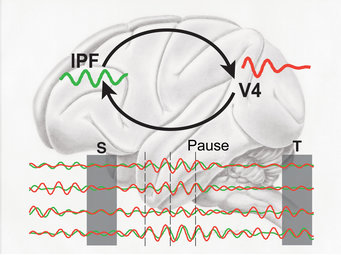Synchronous oscillations in the short-term memory
Scientists have decoded the functioning of the short-term memory
School children and university students are often big fans of the short-term memory – not least when they have to cram large volumes of information on the eve of an exam. Although its duration is brief, short term memory is a complex network of neurons in the brain that includes different brain regions. To store the information, these regions must work together. Researchers from the Max Planck Institute for Biological Cybernetics in Tübingen have now discovered that the participating regions must be active at the same time to enable us to form short-term memories of things that happen.

When we see something, signals from the eyes are processed in areas of the cerebral cortex located at the back of the head. For short-term memory, in contrast, regions in the front part of the cerebral cortex must be active. In order for us to remember something we have seen briefly, these far-apart regions of the brain must collate their information.
How this works can only be examined in apes. Scientists from Nikos Logothetis’s Department at the Max Planck Institute for Biological Cybernetics in Tübingen measured the electrical activity in an optic region and in the front area of the brain while the animals had to remember different images.
In the process, the scientists observed electrical vibrations, known as theta-band oscillations, in the two regions of brain. Surprisingly, these oscillations did not arise independently, but were synchronous. The more synchronously active the regions, the better the animals were able to remember an image.
Accordingly, the functioning of short-term memory can be envisaged as two revolving doors: While the memory is at work, the two doors move in time with each other and, in this way, facilitate the more effective exchange of information.
The study shows how important synchronised brain oscillations are for the communication between the different regions of the brain. Almost all higher intellectual capacities result from the complex interplay of specialised neuronal networks in different parts of the brain.
